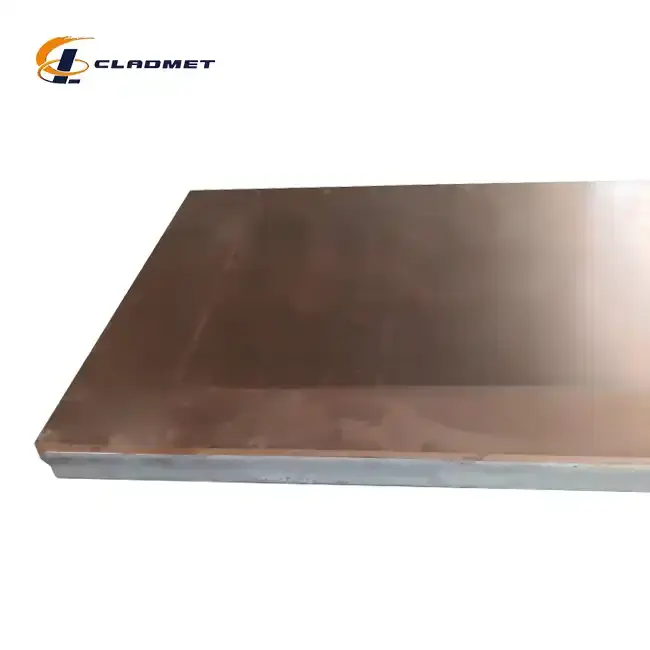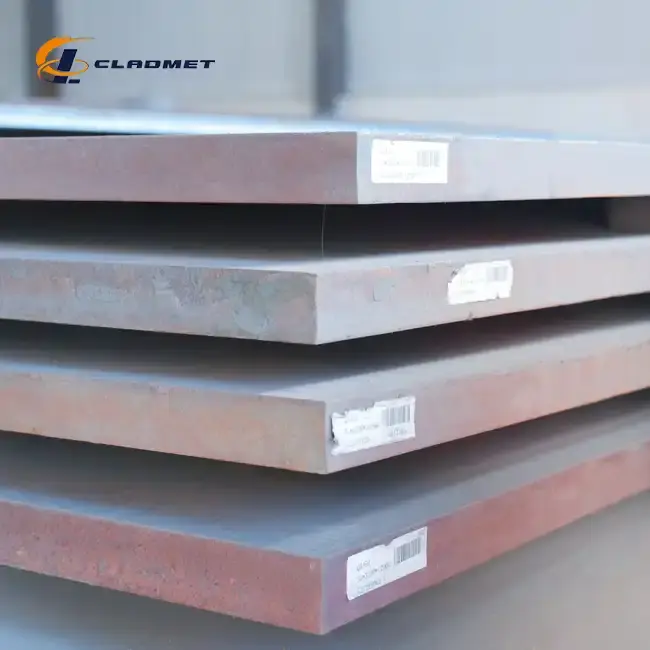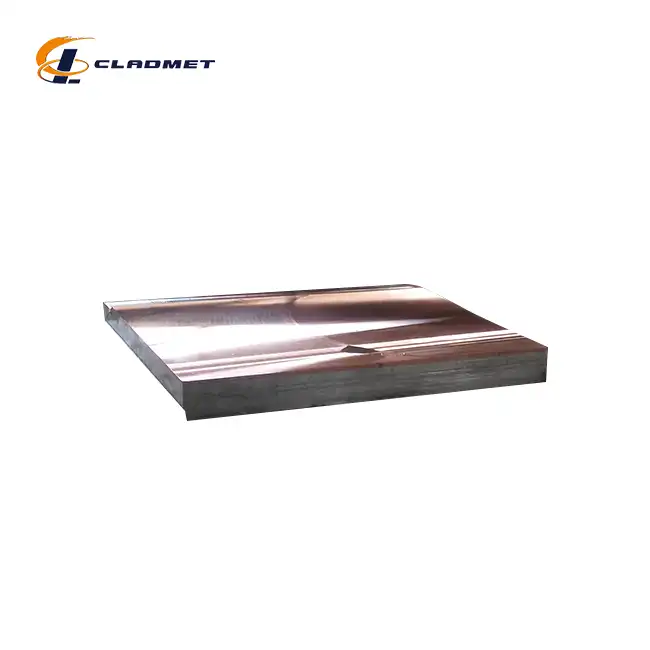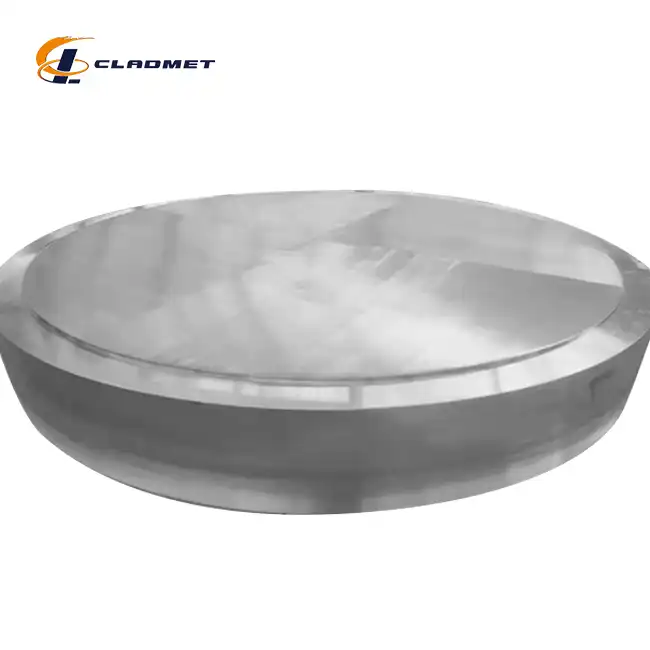How Does the Explosion Bonding Process Ensure Superior Quality in Copper Clad Steel Sheets?
 2025-07-04 10:21:13
View:389
2025-07-04 10:21:13
View:389The explosion bonding process represents a revolutionary manufacturing technique that transforms the production of copper clad steel sheets, delivering unparalleled quality through precise metallurgical control and advanced solid-state welding methods. This sophisticated process creates an atomic-level bond between copper and steel substrates, resulting in composite materials that combine copper's exceptional electrical conductivity and corrosion resistance with steel's superior mechanical strength and structural integrity. The explosion bonding method eliminates the need for intermediate materials or thermal processing, ensuring that each copper clad steel sheet maintains optimal performance characteristics while achieving bond strengths exceeding 130 MPa. Through controlled detonation techniques, manufacturers can produce copper clad steel sheets with consistent quality, precise thickness ratios, and reliable metallurgical properties that meet the demanding requirements of electrical, chemical, and marine industries worldwide.

The Science Behind Explosion Bonding Technology
Metallurgical Principles of High-Velocity Impact Welding
The explosion bonding process relies on fundamental metallurgical principles that govern high-velocity impact welding, creating permanent atomic-level bonds between dissimilar metals without requiring thermal fusion or filler materials. When a controlled explosive detonation accelerates the copper plate toward the steel substrate at velocities exceeding 500 meters per second, the resulting collision generates localized pressures ranging from 1 to 10 GPa, which exceeds the yield strength of both materials and causes instantaneous plastic deformation. This extreme pressure environment facilitates the formation of a characteristic wavy interface pattern, where microscopic jets of material are expelled from the collision zone, removing surface contaminants and oxide layers while enabling direct metal-to-metal contact. The copper clad steel sheet produced through this process exhibits superior bonding strength because the collision parameters can be precisely controlled to optimize the angle of impact, standoff distance, and explosive loading, ensuring consistent metallurgical bonding across the entire surface area. The process generates minimal heat compared to fusion welding methods, preserving the individual properties of both copper and steel while creating a mechanically robust interface that maintains structural integrity under thermal cycling and mechanical stress conditions.
Controlled Detonation Parameters and Quality Control
Achieving superior quality in copper clad steel sheet production requires meticulous control of detonation parameters, including explosive type, charge geometry, standoff distance, and collision angle, all of which directly influence the final bonding characteristics and material properties. The explosive charge must be carefully calculated based on the thickness and properties of both the copper cladding layer and steel substrate, with typical explosive ratios ranging from 0.5 to 2.0 kg per square meter depending on the desired bonding strength and material combination. Standoff distance, typically maintained between 5 to 25 millimeters, determines the copper plate's acceleration profile and collision velocity, which must be optimized to achieve the critical velocity range necessary for metallurgical bonding while avoiding excessive deformation or shock-induced damage. Quality control measures during the explosion bonding process include real-time monitoring of detonation wave propagation, post-bonding ultrasonic testing to verify bond integrity, and metallographic examination of the interface structure to confirm proper wave formation and atomic-level bonding. Advanced facilities like those operated by Baoji JL Clad Metals Materials Co., Ltd. employ sophisticated explosive handling systems and controlled detonation chambers that ensure consistent results while maintaining strict safety protocols, enabling the production of copper clad steel sheets that consistently meet or exceed international standards including ASTM B432 and ASME SB-432 specifications.
Interface Characterization and Bond Strength Analysis
The quality of explosion-bonded copper clad steel sheets can be scientifically evaluated through comprehensive interface characterization techniques that analyze the microscopic structure, chemical composition, and mechanical properties of the bonding zone. Scanning electron microscopy reveals the characteristic wavy interface morphology, with wave amplitudes typically ranging from 50 to 500 micrometers and wavelengths between 200 to 2000 micrometers, depending on the explosion parameters and material properties. Energy-dispersive X-ray spectroscopy analysis of the bonding interface demonstrates the absence of intermetallic compounds or diffusion layers, confirming that the explosion bonding process creates a purely mechanical bond without altering the fundamental chemistry of either the copper or steel components. Mechanical testing protocols, including peel strength testing, shear strength evaluation, and tensile testing, consistently demonstrate that properly explosion-bonded copper clad steel sheets achieve bond strengths exceeding 130 MPa in shear and 100 MPa in peel configurations, values that significantly surpass those achievable through conventional adhesive bonding or brazing techniques. The interface structure remains stable under thermal cycling conditions, with bond strength retention exceeding 95% after exposure to temperature fluctuations between -40°C and 200°C, making these materials ideal for applications in harsh environmental conditions where reliability and long-term performance are critical requirements.
Process Optimization for Enhanced Material Properties
Advanced Surface Preparation Techniques
Superior quality in copper clad steel sheet production begins with advanced surface preparation techniques that ensure optimal bonding conditions by removing contaminants, oxides, and surface irregularities that could compromise the explosion bonding process. The steel substrate undergoes comprehensive cleaning procedures including degreasing with industrial solvents, mechanical abrasion using controlled grit blasting with aluminum oxide or steel shot, and chemical etching with dilute acid solutions to remove mill scale and surface oxides while creating a uniform surface roughness profile. Copper plate preparation involves similar cleaning protocols, with particular attention to removing copper oxides and organic contaminants that form during storage and handling, typically accomplished through pickling in dilute sulfuric acid followed by thorough rinsing and drying under controlled atmospheric conditions. Surface roughness measurements using profilometry techniques confirm that optimal bonding occurs when the steel substrate maintains an average roughness (Ra) between 3 to 8 micrometers, while the copper surface should exhibit minimal oxidation and uniform grain structure as verified through optical microscopy. Quality control laboratories at facilities like Baoji JL Clad Metals Materials Co., Ltd. employ advanced analytical techniques including X-ray photoelectron spectroscopy to verify complete removal of surface contaminants and Auger electron spectroscopy to confirm the absence of subsurface oxide layers, ensuring that each copper clad steel sheet begins the explosion bonding process with ideal surface conditions for maximum bonding effectiveness.
Explosive Selection and Charge Configuration
The selection and configuration of explosive materials represents a critical factor in achieving superior quality copper clad steel sheets, requiring careful consideration of detonation velocity, pressure generation characteristics, and explosive stability to optimize the bonding process while maintaining safety and consistency. High-explosive compounds such as PETN, RDX, or specially formulated plastic explosives are selected based on their ability to generate consistent detonation waves with velocities ranging from 6,000 to 8,500 meters per second, providing the precise energy delivery necessary for metallurgical bonding without causing excessive shock damage to the base materials. Charge configuration involves creating uniform explosive layers with controlled thickness variations typically maintained within ±5% across the entire bonding surface, achieved through precision casting or pressing techniques that ensure consistent explosive density and eliminate air gaps or voids that could cause irregular detonation propagation. The explosive-to-metal mass ratio must be carefully calculated based on the specific properties of the copper and steel components, with typical ratios ranging from 0.8 to 1.5 depending on material thickness, hardness, and desired bonding characteristics. Advanced facilities utilize computer modeling and simulation software to predict optimal explosive configurations, followed by validation through test shots and metallurgical analysis to confirm that the selected parameters produce copper clad steel sheets with consistent quality and performance characteristics that meet stringent industry requirements for electrical conductivity, corrosion resistance, and mechanical strength.
Post-Processing and Quality Enhancement
Following the explosion bonding operation, copper clad steel sheets undergo sophisticated post-processing procedures designed to optimize material properties, relieve residual stresses, and enhance overall quality through controlled thermal treatment and mechanical finishing operations. Stress relief annealing is performed at carefully controlled temperatures typically ranging from 300°C to 500°C, depending on the steel grade and copper alloy composition, with precise time-temperature profiles designed to reduce residual stresses while preserving the metallurgical bond integrity and maintaining optimal electrical conductivity in the copper layer. Hot rolling processes may be applied to achieve precise thickness control and improve surface finish, with rolling temperatures and reduction ratios carefully optimized to enhance bond uniformity while avoiding excessive deformation that could compromise the interface structure. Quality enhancement procedures include precision machining to achieve specified dimensional tolerances, surface grinding to eliminate irregularities and create uniform thickness profiles, and specialized finishing treatments such as passivation or protective coating application to enhance corrosion resistance in specific service environments. Comprehensive testing protocols verify that post-processed copper clad steel sheets maintain their superior properties, including electrical conductivity measurements that confirm values exceeding 99% IACS for high-purity copper grades, corrosion resistance testing in simulated service environments, and mechanical property evaluation to ensure that bond strength and material integrity remain within specified limits throughout the entire manufacturing process.

Applications and Performance Advantages in Industrial Settings
Electrical Power Systems and High-Conductivity Applications
Copper clad steel sheets produced through explosion bonding technology demonstrate exceptional performance in electrical power systems and high-conductivity applications, where the combination of copper's superior electrical properties with steel's mechanical strength creates optimal solutions for demanding industrial environments. In electrical switchgear applications, these materials provide reliable current-carrying capacity while maintaining structural integrity under fault conditions, with the steel substrate preventing deformation during electromagnetic forces while the copper layer ensures low electrical resistance and efficient power transmission. Bus bar systems fabricated from explosion-bonded copper clad steel sheets exhibit superior performance characteristics compared to solid copper alternatives, offering reduced material costs while maintaining equivalent electrical conductivity and providing enhanced mechanical strength for spanning long distances without intermediate supports. The materials demonstrate excellent performance in transformer applications, where the copper layer provides efficient electrical conduction while the steel core contributes to mechanical stability and thermal management, resulting in improved efficiency and reduced maintenance requirements over extended service periods. Power distribution equipment utilizing these materials benefits from the superior corrosion resistance of the copper surface combined with the structural durability of the steel substrate, enabling reliable operation in harsh environmental conditions including high humidity, salt spray, and industrial chemical exposure. Advanced manufacturing facilities like Baoji JL Clad Metals Materials Co., Ltd. produce copper clad steel sheets with customized electrical properties, offering thickness ratios optimized for specific applications and ensuring compliance with international electrical standards including IEC and IEEE specifications for power system components.
Chemical Processing and Corrosion-Resistant Applications
The unique properties of explosion-bonded copper clad steel sheets make them ideal for chemical processing applications where superior corrosion resistance must be combined with mechanical strength and economic efficiency. In chemical reactor construction, these materials provide excellent resistance to organic acids, alkaline solutions, and various chemical compounds while maintaining structural integrity under pressure and temperature cycling conditions, with the copper layer acting as an effective barrier against corrosive attack while the steel substrate provides necessary mechanical support. Heat exchanger applications benefit significantly from the thermal conductivity of copper combined with the strength and formability of steel, enabling the production of efficient heat transfer equipment that maintains performance over extended service periods while reducing maintenance and replacement costs. The materials demonstrate exceptional performance in electrochemical applications, including electroplating systems where the copper surface provides uniform current distribution while the steel backing ensures dimensional stability and prevents warping under electrical stress. Marine applications utilize the superior seawater corrosion resistance of copper clad steel sheets in shipbuilding, offshore platforms, and desalination equipment, where the combination of properties enables long-term performance in challenging saltwater environments while reducing lifecycle costs compared to alternative materials. Specialized chemical processing equipment, including reaction vessels, piping systems, and storage tanks, benefits from the ability to customize copper layer thickness and steel substrate composition to match specific chemical compatibility requirements while maintaining optimal mechanical properties for pressure vessel applications.
Architectural and Structural Applications
Modern architectural and structural applications increasingly rely on explosion-bonded copper clad steel sheets to achieve both aesthetic appeal and functional performance in building systems, roofing applications, and decorative elements that require long-term durability and weather resistance. Building envelope systems utilize these materials for their superior corrosion resistance and attractive appearance, with the copper surface developing natural patina over time while the steel substrate provides structural support and dimensional stability under wind loads and thermal expansion. Roofing applications benefit from the combination of copper's traditional aesthetic appeal with enhanced structural performance, enabling the creation of large-span roof systems with reduced support requirements while maintaining the classic appearance and longevity associated with copper roofing materials. Architectural cladding systems fabricated from copper clad steel sheets offer designers the flexibility to create complex geometric forms while ensuring structural integrity and weather resistance, with the explosion bonding process enabling the production of curved and formed panels that maintain bond integrity throughout the fabrication process. The materials provide excellent performance in coastal and industrial environments where atmospheric corrosion is a concern, with the copper layer providing long-term protection while the steel substrate ensures structural reliability over extended service periods. Specialized architectural applications, including ornamental metalwork, sculptural elements, and historic building restoration projects, benefit from the ability to achieve traditional copper appearance while providing enhanced structural performance and reduced material costs compared to solid copper alternatives, making these materials increasingly popular for both new construction and renovation projects where heritage compatibility is required.
Conclusion
The explosion bonding process represents the pinnacle of metallurgical engineering, ensuring superior quality in copper clad steel sheets through precise control of atomic-level bonding mechanisms that create durable, high-performance composite materials. This advanced manufacturing technique combines copper's exceptional electrical conductivity and corrosion resistance with steel's superior mechanical strength, producing materials that exceed industry standards for bond strength, durability, and performance consistency. Through meticulous process optimization, advanced quality control, and comprehensive testing protocols, explosion-bonded copper clad steel sheets deliver reliable solutions for electrical, chemical, and structural applications where traditional materials cannot meet demanding performance requirements.
Partner with Baoji JL Clad Metals Materials Co., Ltd. to experience the advantages of our independent explosive composite technology, international certifications including ISO9001-2000, PED, and ABS qualifications, and comprehensive OEM/ODM customization services. Our technological superiority encompasses innovative products, advanced processes, and cutting-edge trends that define industry standards. With extensive R&D capabilities and global sales reach, we deliver tailored solutions that meet your unique specifications while ensuring consistent quality and reliability.
Transform your projects with our premium copper clad steel sheets that combine proven metallurgical excellence with competitive economics. Contact our technical team today at sales@cladmet.com to discuss your specific requirements and discover how our explosion bonding technology can enhance your applications with superior performance, extended service life, and exceptional value.
References
1. Crossland, B., & Williams, J.D. (1970). Explosive Welding of Metals and Its Application. Oxford University Press.
2. Bahrani, A.S., Black, T.J., & Crossland, B. (1967). The mechanics of wave formation in explosive welding. Proceedings of the Royal Society of London. Series A, Mathematical and Physical Sciences, 296(1445), 123-136.
3. Findik, F. (2011). Recent developments in explosive welding. Materials & Design, 32(3), 1081-1093.
4. Mousavi, S.A.A., & Al-Hassani, S.T.S. (2008). Numerical and experimental studies of the mechanism of the wavy interface formations in explosive/impact welding. Journal of Mechanics of Materials and Structures, 3(4), 639-650.

_1737007724117.webp)
_1736996330512.webp)









